The Great American Eclipse has begun! Around the country, people are in position for prime viewing. Follow along here to catch all the action.
- Here’s how to watch the eclipse safely
- Nine places to watch the eclipse around Los Angeles
- Watch the Great American Eclipse online right here
- Tips for taking the best pictures of the eclipse
- Share via
Ready for a recap? Watch ‘Eclipse Over America’ tonight on NOVA
That’s a wrap!
The moon’s shadow has left South Carolina and moved out to sea. That means the Great American Eclipse is over.
But in just a few hours, you can relive the experience on TV with the science series NOVA.
“Eclipse Over America” is an hour-long documentary recounting the day’s events. Producers will incorporate footage from public television stations in cities that happened to be along the path of totality, the roughly 70-mile-wide swath of the country that experienced a total eclipse.
Here’s a preview:
The program will also explain how scientists take advantage of eclipses to learn more about the sun and its solar storms. (For more about the experiments scientists conducted during the eclipse, read our story here.)
The show will be broadcast at 9 p.m. on public television stations around the country, including PBS SoCal in Southern California.
- Share via
How they watched an eclipse in 1932
Boy, they used to dress up for a solar eclipse.
This may look like a scene from an old-timey movie, but it’s an actual photo of people taking in a partial eclipse of the sun from the observation deck of the Empire State Building in New York City.
The photo was taken on Aug. 31, 1932. Though the skywatchers are wearing dresses, ties and nice hats, some of them appear to be missing the most important accessory: eclipse glasses.
In lieu of the solar-safe specs, many of the men, women and children squinted at the sun through a protective film. But a few seem to have relied on their sunglasses, or simply held up a hand to shade their eyes from the sun.
- Share via
At Grand Ole Opry, the band stopped playing and cicadas started chirping as darkness fell on Nashville
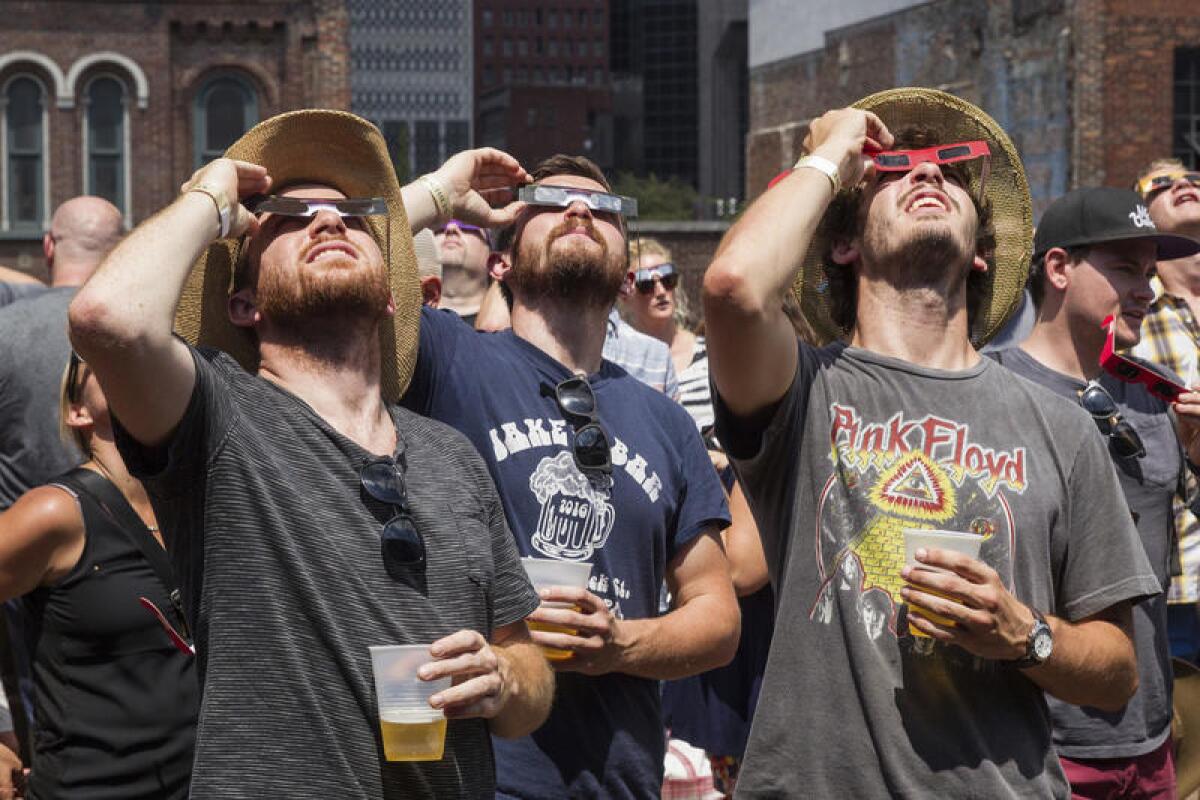
As darkness fell outside the Grand Ole Opry, the band onstage stopped playing. The temperature dropped. Cicadas started chirruping in the trees. Eclipse-watchers who had hidden in the shade to hide from the heat came out for one last look at the sun as dusk fell in midday and everything went dark.
Viewed through the proper protective glasses, everything was black except for a tiny sliver of the sun. Then the tiny sliver disappeared, and everyone took off their glasses and looked at where the sun used to be.
The moon was black and rimmed with white fire.
And the crowd cheered.
But then, just as suddenly, a passing cloud swallowed the moon, and the crowd groaned as the sky turned dark. By the time the cloud passed, so had the totality. The first sign of a return to normalcy was a flagpole bearing the American flag, which flowed with the faint orange of a sunrise, and soon everything felt back to normal.
“I felt a sense of awe about nature ... the whole totality of the universe,” said Lisa Wilbanks, 57, of Louisville, Ky., moments after the eclipse passed, with awe still in her voice.
When the moon began blocking the sun, Wilbanks said, she was glad not just to see the eclipse, but also felt “blessed and really grateful that we have science to tell us these things.”
- Share via
These eclipse addicts go to great lengths, again and again, to stand in awe of the heavens
Millions of people will look up to the heavens today as a total solar eclipse sweeps across the continental U.S. for the first time in nearly 100 years.
For the vast majority of skywatchers, the “Great American Eclipse” will be the first time they’ll experience the eerie darkness that falls when the moon completely obscures the face of the sun.
But for a dedicated few, eclipse-chasing is a lifelong habit.
The desire to stand again and again in the shadow of the moon has taken scientists, photographers and at least one astronomy-loving monsignor to Indonesia, Kenya, Bolivia and the Arctic archipelago, among other distant locales. They have chartered planes to see the eclipse from air and hired boats to view it from the sea.
These self-proclaimed eclipse addicts track the cumulative number of minutes they have spent in totality, when the sun is entirely covered and day turns to night. They pore over weather statistics to increase their chances of being in a spot with clear skies. They make plans years in advance.
Eclipse-chasing is an expensive pursuit, but those who love it say it is well worth it. They are certain that after the Great American Eclipse, their ranks will swell.
- Share via
Artists turn to science in rendering the emotion of past eclipses
Thousands — millions? — of eyes gazed toward the heavens Monday for the first total solar eclipse to cross the United States in nearly 100 years. It swept on a “path of totality” from Oregon through South Carolina.
Before and after the event, the Alyce de Roulet Williamson Gallery at the ArtCenter College of Design in Pasadena is celebrating with the exhibit “Eclipse.”
“I wanted to reference the symbolism we’ve attached to solar eclipses and the profound emotion and transcendent experiences people have,” gallery director Stephen Nowlin said. “I wanted to keep the show in the context of real science, not new ageism or pseudoscience.”
Displayed throughout the cavernous rooms are interpretive visual artworks, artifacts, documents and projections, including a montage of images from scientific eclipse expeditions carried out by the Lick Observatory near San Jose in the late 19th and early 20th century.
“Back then there was no spacecraft to examine the sun,” Nowlin said. “The only way astronomers could get a good look at the corona of the sun was to travel on arduous expeditions into remote areas of the world.”
- Share via
Angelenos flood Griffith Observatory for a glimpse of solar eclipse
As the moon slid over a bright orange sun Monday morning, Southern Californians flocked to Griffith Observatory to catch a glimpse of the solar eclipse.
Angeline Santiago and Mark Javier waited more than an hour in line to view the eclipse through the focused eye of a telescope.
The Daly City pair have been in Southern California since Wednesday visiting family and searched online to see where the best place to see the solar event would be.
The results said: Griffith Observatory.
So at 7 a.m. the couple threw on some clothes and called an Uber. By the time they got to the observatory, the eclipse was only minutes away and the line to buy special sunglasses was impractically long.
In a lapse of patience, Javier admitted that he did what everyone told him not to do, and he looked at the sun.
- Share via
At Little League World Series, the game goes on but fans watch the eclipse
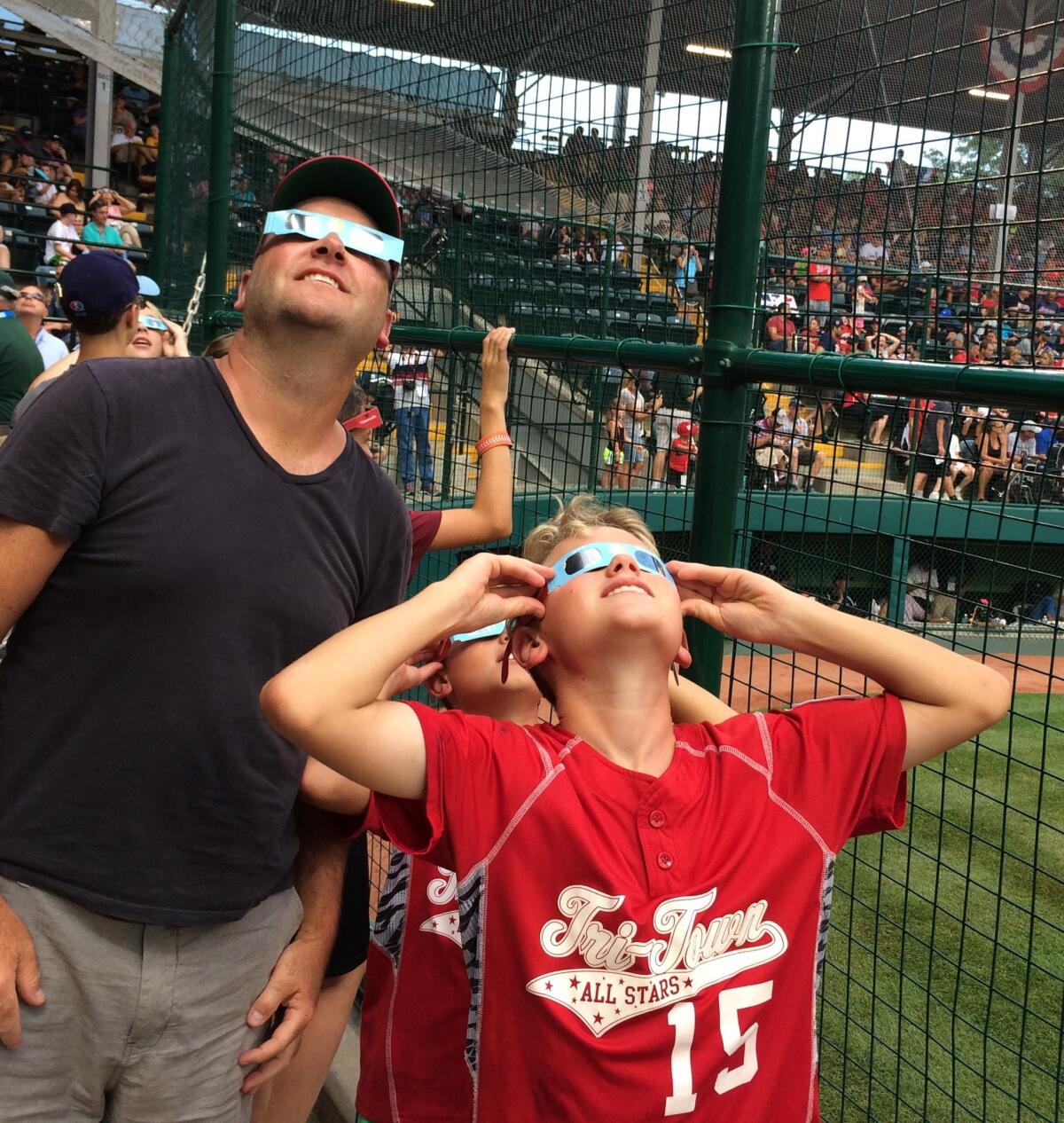
The team from Rancho Santa Margarita in south Orange County had just taken the field for pregame warm-ups at about 2:40 p.m. EDT Monday when the solar eclipse reached its height here at the site of the Little League World Series.
Few of the players looked up, but many fans turned their backs on the field and gazed toward the skies while ESPN announcers Karl Ravech and Aaron Boone left their broadcast booth and came down into the stands for a better look.
The eclipse was about 85% of totality in north-central Pennsylvania, but that was enough to darken the sky considerably, turning midafternoon to dusk for about half an hour. The temperature dropped about 10 degrees.
The lights at the two Little League World Series stadiums were turned out in late morning, in anticipation of the eclipse, and remained on through the rest of the day.
Rancho Santa Margarita was playing a team from Jackson, N.J., in an World Series elimination game on Monday.
- Share via
Bill Nye on the meaning of the eclipse: ‘We are all citizens of the same planet’
There’s nothing like an eclipse to bring humanity together. Just ask Bill Nye.
The self-styled “Science Guy” and Planetary Society CEO says the eclipse is a reminder that we earthlings are part of one big family.
Here’s how he put it:
“Experiencing an eclipse changes the way we feel about space and how we are connected. I hope this moment reminds us all that we share a common origin among the stars, and that we are all citizens of the same planet.
“I hope each of us takes a moment to consider the diligence of our ancestors, who came to understand our Solar System’s planets and moons, who measured the fantastic distances between them, and came to know their orbital motions. That we humble humans can understand all of this is remarkable. It fills me with optimism about our species and our future. ...
“Let’s celebrate together and marvel at humankind’s ability to observe this phenomenon, and to understand the cosmos and our place within it.”
Nye released his statement from the Homestead National Monument of America in Beatrice, Neb. After totality has passed, he will help lead attendees through the National Park Service’s new Eclipse Junior Ranger Program.
- Share via
California’s power grid, which gets up to 40% of its energy from the sun, has a plan for dealing with the eclipse
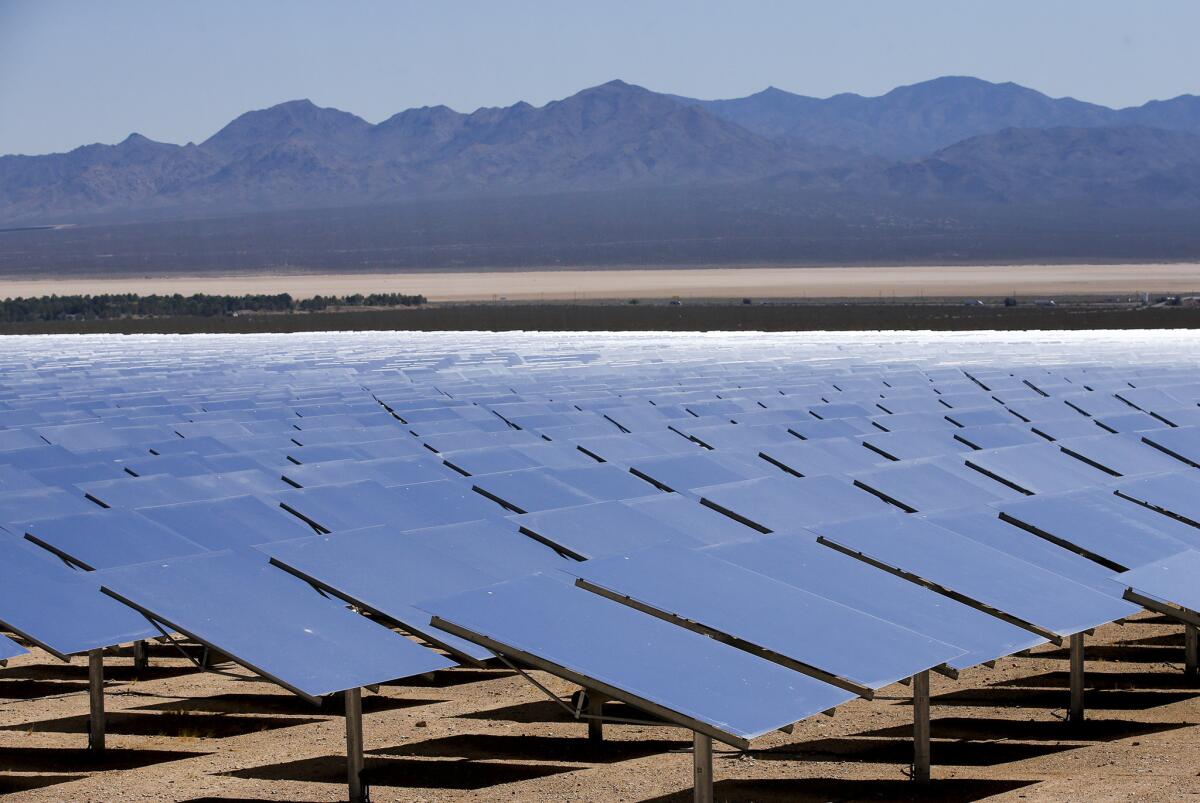
Although the moon will push in front of the sun and darken the skies on Monday, California’s solar-heavy electricity grid isn’t expected to run short on energy to power homes, businesses and industry.
The manager of the state’s electricity grid, the California Independent System Operator, said it’s prepared for the widely anticipated solar eclipse that begins about 9 a.m.
The moon will block the sun for 2 minutes and 40 seconds about an hour after the eclipse begins. California is too far south for total blockage of the sun, but eclipse viewers in the state will see the moon cover about 50% to about 90% depending on where they are.
“Our team is committed to keeping the power flowing for Californians, as we navigate the unusual circumstances presented by the eclipse,” said Steve Berberich, president of Cal-ISO. “I am confident in the technology of our market and grid, and in the expertise and abilities of our staff to manage the operational challenges associated with the eclipse.”
- Share via
Tears after the total eclipse in Oregon: ‘It was so pretty. It was just so pretty’
It took Amy Steele, an astronomy graduate student at the University of Maryland, about 20 minutes to stop crying after the moment of totality passed in Salem, Ore.
“It was so pretty,” she said, over and over again. “It was just so pretty.”
“The moon was so black,” she continued. “It was black like a hole in the sky. And Mercury! We never get photons from Mercury. It was so good.”
Erin Meadors, who is about to enter her sophomore year at Williams College, darted around the terrace of a brick building sharing eight-minute video she took of the celestial event with friends, coworkers and even a few strangers.
Meadors has spent her whole summer preparing for the moment that just passed, checking camera and telescope equipment and then packing the instruments for the trip from Massachusetts to Oregon.
Was it worth it?
“Oh my gosh,” she gushed. “It was more than worth it. I should have been planning my whole life for this.”
- Share via
They’re being followed by a moon shadow: Fun with the eclipse in Nashville
- Share via
Total eclipse in the digital age: ‘There’s like an Instagram filter on everything’
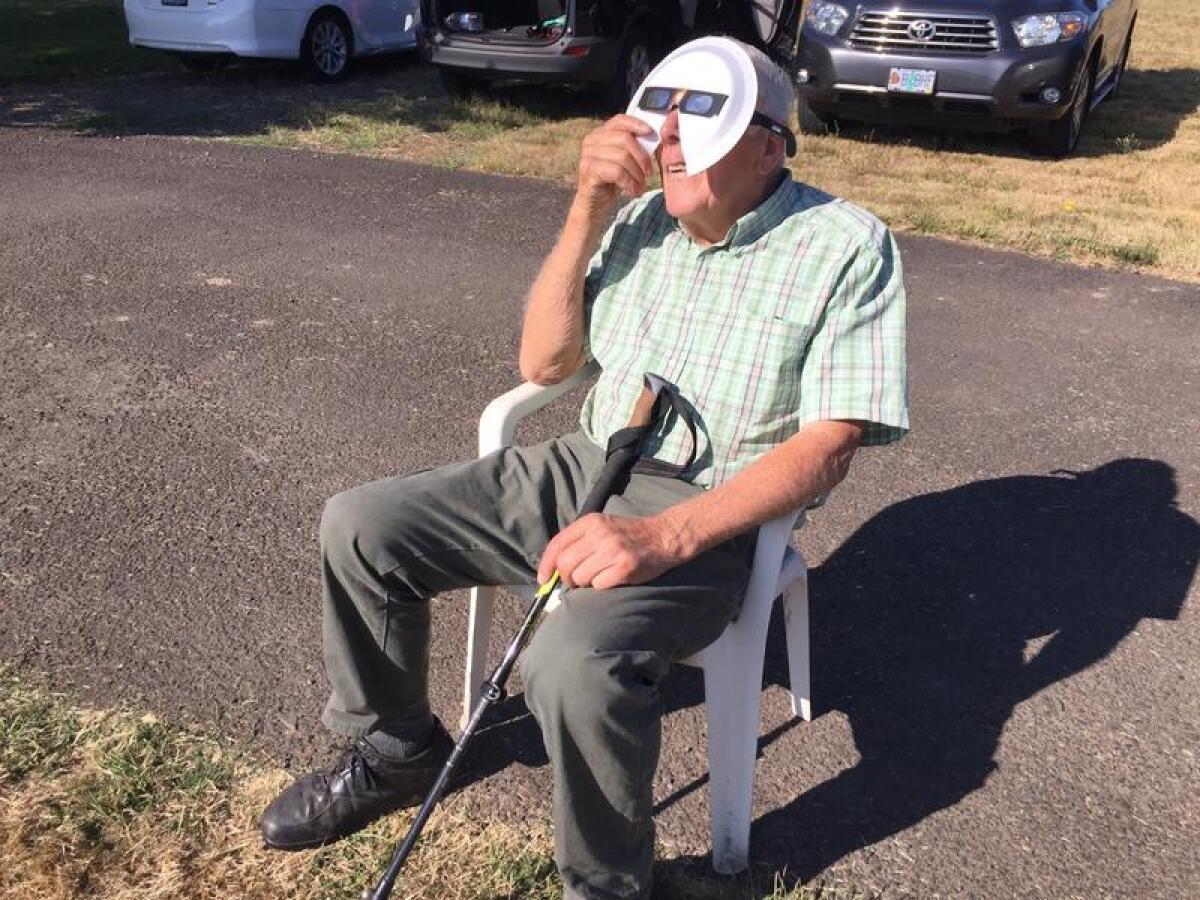
Thirty members of the Richard family gathered in the front yard of patriarch Bob Richard Sr.’s home in rural Albany, Ore., setting up tents, lawn chairs and blankets for the big event. A local radio station’s broadcast of Pink Floyd’s “Dark Side of the Moon” played from nearby speakers.
As totality neared, the temperature dropped. A 360-degree hazy dusk enveloped the countryside. Swallows began swooping and diving before taking off in a flock into the “night” sky.
“It’s getting darker! There’s like an Instagram filter on everything,” said Jenny Carlson, 45, a pharmacist from Tigard, Ore.
Her older brother, Bob Richard Jr., 65, simply said: “Far out, man.”
Afterward, Bob Richard Sr., still donning the solar eclipse mask that one of his daughters made — involving a cut-out Styrofoam plate affixed to a pair of eclipse glasses — the 88-year-old marveled at what he had just witnessed.
“This was something,” he said. “You couldn’t dream it.”
- Share via
The moon’s shadow comes to Hopkinsville, Ky., the point of greatest eclipse
The eclipse has now passed Hopkinsville, Ky., the “point of greatest eclipse.”
The point of greatest eclipse is actually a point in time, not a physical place, said Renee Weber, a planetary scientist at NASA’s Marshall Space Flight Center in Huntsville, Ala.
More specifically, it’s when “the axis of the moon’s shadow is pointed most directly at the center of the Earth,” Weber explained on NASA TV.
Hopkinsville happens to be the place on the surface of the Earth where that alignment occurs. That’s why the town earned the nickname “Eclipseville.”
One upshot of being at the point of greatest eclipse is that the shadow of the moon, or umbra, is more circular there than anywhere else in the world.
Shortly after totality began, Weber was able to see Jupiter and some other planets in the daytime sky.
“I just have goose bumps all over my body,” she said. “I think I’m hooked. I’m an addict.”
She also pointed out that “you’re really looking at the moon when you’re watching a solar eclipse,” not the sun.
The eclipse has now passed over half of the country. The moon’s shadow is on its way to Charleston, S.C., traveling at about 1,500 miles per hour.
- Share via
Miss today’s eclipse? Another one is coming in 2024
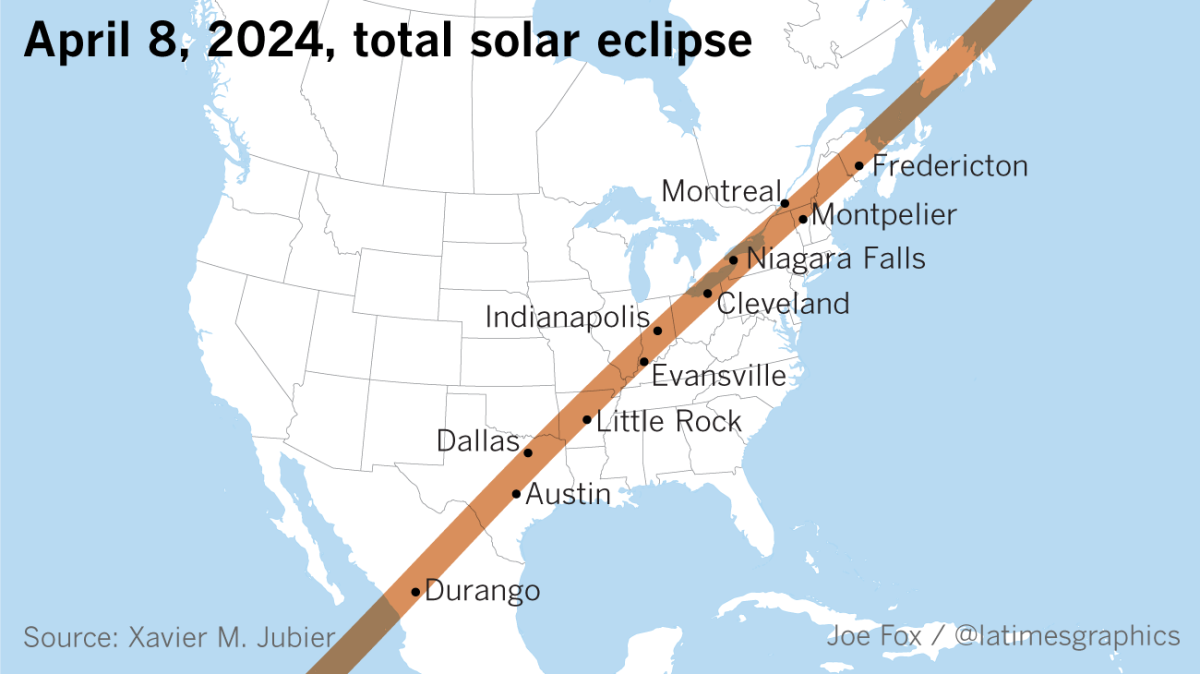
The Great American Eclipse is over. But don’t toss those glasses just yet. (No, they don’t “expire,” despite what you may have heard.)
Before today’s eclipse, it had been 38 years since the last total solar eclipse visible from the United States. Thankfully, you won’t have to wait that long until the next one: A total eclipse will sweep up through Texas and across the Midwest and East Coast on April 8, 2024.
Thousands of people road-tripped to places along the path of the Great American Eclipse. Hotels along the path of totality reported being fully booked years in advance, and small towns were overwhelmed by the influx of eclipse seekers. So now’s your chance to get things booked ahead of time.
And if you can’t wait that long, a total solar eclipse will reach South America on July 2, 2019.
- Share via
Do you have an eclipse horror story? We want to hear it
It’s finally here: The Great American Eclipse.
Perhaps you’re one of the folks who reserved a hotel room in the path of totality back in 2015. Maybe you persuaded a farmer to let you set up camp in his geographically desirable cornfield for the day. Or you could be the type of person who just decided to hop in your car and wing it.
If you’re lucky, everything will go off without a hitch. But let’s face it: There’s a lot that could go wrong.
You might be stuck in traffic as skies start to darken.
You might find yourself spending hours waiting in line for a port-a-potty.
You might not be able to find a pair of essential eclipse glasses.
Your might even be thwarted by a few inconveniently placed clouds.
If your eclipse experience goes bad, we want to hear about it. Send your story to amina.khan@latimes.com. If you’ve got photos or video, we’d love to see those too.
- Share via
California lawmakers awed by the solar eclipse
- Share via
Solar marketing
- Share via
See the phases of the total eclipse, all in one shot
- Share via
‘Happy totality’
- Share via
What does an eclipse sound like? In Nashville, they’re playing an atmospheric soundtrack
- Share via
Cows in the fields lay down as eclipse looms over Oregon
- Share via
‘Still trembling’ after first total solar eclipse
- Share via
Just before totality was ‘like being on a different planet’
At a few minutes to go until totality, the physical changes wrought by the eclipse felt strange.
The temperature dropped five degrees since the eclipse began. But that’s not all.
“The sun feels wrong – it’s not bright enough, it’s not warm enough, the color is different,” said Dan Seaton, a solar physicist at the University of Colorado in Boulder who came to Salem for the big event.
“It’s like being on a different planet.”
- Share via
In Oregon, the sky is darkening and the temperature is dropping
- Share via
Countdown to totality in Oregon
- Share via
How to have fun with shadows during the Great American Eclipse
Even if you are not in the path of totality you can still have a lot of fun with the eclipse.
Here in Salem, Ore., the astronomy team (and this reporter) are messing around with making pinhole projections of the partially eclipsed sun. We’re using all kinds of things: our fingers, a cheese grater, and even the small holes of one team member’s hat.
The smaller the gaps, the more pronounced the projections will be. And the more the sun gets covered, the sharper the image will be.
Have fun!!
- Share via
Will the Great American Eclipse make animals act strangely? Science says yes
It’s not just humans who will be affected by the Great American Eclipse today — expect animals to act strangely too.
Anecdotal evidence and a few scientific studies suggest that as the moon moves briefly between the sun and the Earth, causing a deep twilight to fall across the land, large swaths of the animal kingdom will alter their behavior.
Eclipse chasers say they have seen songbirds go quiet, large farm animals lie down, crickets start to chirp and chickens begin to roost.
Totality — the time when the face of the sun is fully covered by the moon — only lasts a few minutes, but scientists say it is still capable of affecting animals who use light cues to help them decide what to do and when.
“Certain stimuli can overrule normal behavior without affecting an animal’s daily physiological rhythms,” said Joanna Chiu, who studies animal circadian clocks at UC Davis. “It is not surprising that the eclipse will temporarily affect animal behavior, but it is unlikely to affect their internal clock or their behavior in the long run.”
- Share via
California forecast: Cloudy with a chance of viewing a solar eclipse today
The solar eclipse has finally begun, but coastal Californians might find their view obscured by clouds, experts say.
The National Weather Service said that California was mostly cloudy Monday morning, but a hovering marine layer should thin out by the time the eclipse reaches its peak.
Here’s what California sky watchers can expect:
- Share via
In Kentucky, the eclipse is a hot ticket — and they mean that literally
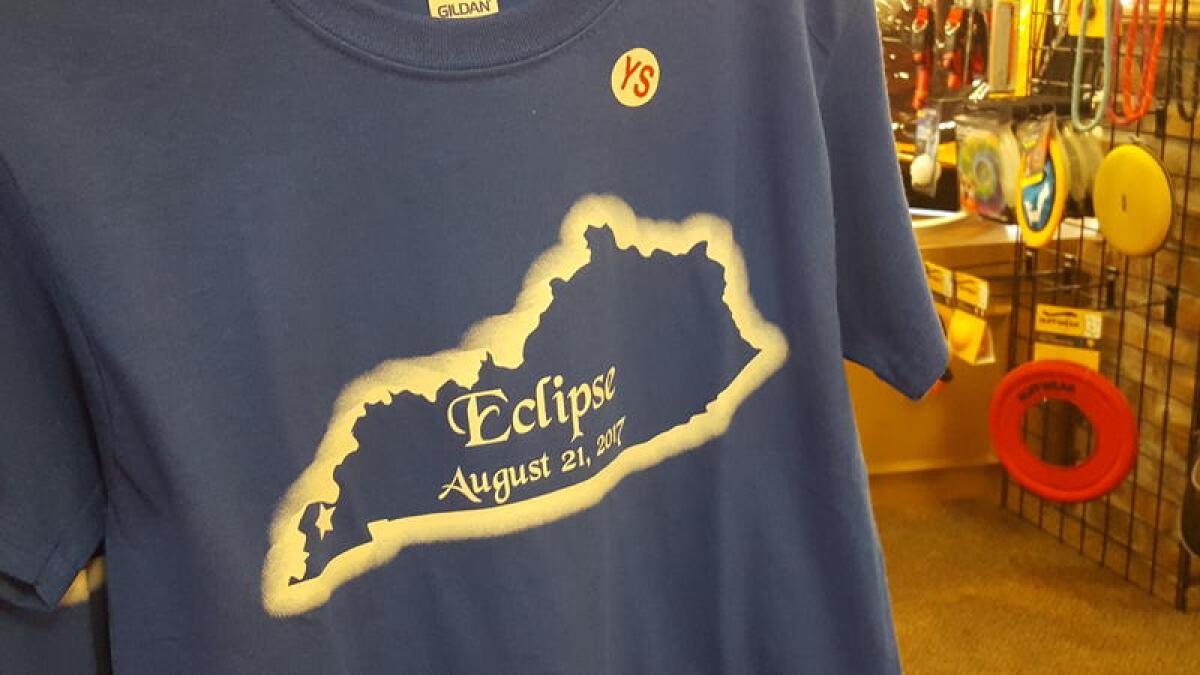
Weather-worn travelers in Kentucky quietly sought out shade in the shadows of trees, a 10-foot flood wall and the underside of an event deck alongside the Ohio River.
Some were wearing T-shirts bearing the emblem of the solar event: Eclipse, August 21, 2017.
The local National Weather Service station issued a heat advisory early Monday for this town of 25,000, with humidity making it feel like more than 100 degrees by close to midday.
A couple of hundred people, mostly from the South, Rust Belt and Midwest, based on license plates around town, had gathered at Paducah’s riverfront park, where the Ohio and Tennessee rivers meet. Conversation was sparse as the eclipse-goers picnicked, napped and generally sought to do as little as possible in the scorching sun.
- Share via
The view from Jackson Hole, Wyo.
- Share via
‘It’s a lot of pressure’ for students preparing to gather scientific data during the eclipse
These students from Williams College have spent the last two and a half months preparing for the total solar eclipse. That includes testing equipment, assembling solar filters — and then packing it all up to ship from Massachusetts to Oregon.
All this, to gather as much data as possible during less than two minutes of totality.
How does that make them feel?
Ross Yu, who is about to start his junior year, put it this way: “It’s a lot of pressure.”
- Share via
Eclipse is underway in Oregon
- Share via
Clear skies in Los Angeles for eclipse viewing
- Share via
For viewing eclipses, everything old can be new again
Williams College astronomer Jay Pasachoff has been witnessing solar eclipses since 1959. (Today will be the 34th time he will stand in totality.)
But that little magnifying-glass-looking thing he’s holding goes much further back.
It’s a solar viewer from 1793. It was built to observe an eclipse over London that year.
The viewer has red glass in it that should be dark enough to protect an observer’s eye from the harsh light of the sun. Pasachoff intends to try it right after first contact.
Below are the instructions that came with it more than 200 years ago.
- Share via
A run on glasses and cookies as a North Carolina town awaits the eclipse
Jennifer and Nathan Garnett know how to make a day of a football game, and they decided to see if the highly anticipated solar eclipse would be a similar experience.
They parked their truck in a library parking lot in Brevard, N.C., where they were expecting friends and hours of lawn games.
The Garnetts live in Mills River, only about 15 miles east of Brevard. “But when you’re so close to totality, why not see it?” said Nathan Garnett, who runs an insurance business.
Shyloh Elder traveled from New York City for the big event.
“The eclipse was on my bucket list,” said the 26-year-old, who works in data science.
Her mother, MaryBeth Elder, joined her from Ligonier, Pa. She had heard that Brevard was a quaint town where the total solar eclipse is to be visible at 2:37 p.m. local time.
They considered spaces that were more open, including the numerous national parks in the area and off the Blue Ridge Parkway, but decided not to fight the crowds on mountainous two-lane roads.
Retail stores were open and trying to capitalize on the influx of visitors. But banks and government offices either curtailed their hours to the morning or were closed for the day.
Katina Hansen, who owns Blue Ridge Bakery with her husband John, couldn’t stop smiling as people crowded her showcases of cinnamon rolls, cupcakes, scones and more. Business was nearly triple what it would be on a normal Monday, she said, with many customers asking for the yellow-iced eclipse cookies. She sent her bakers back to their ovens two times to make more.
Eclipse glasses, given away earlier in the week, were now selling for up to $10. A frenzied mother was heard directing a companion to “buy them anyway.”
- Share via
For eclipse viewers in South Carolina, it was already ‘parking lot full’
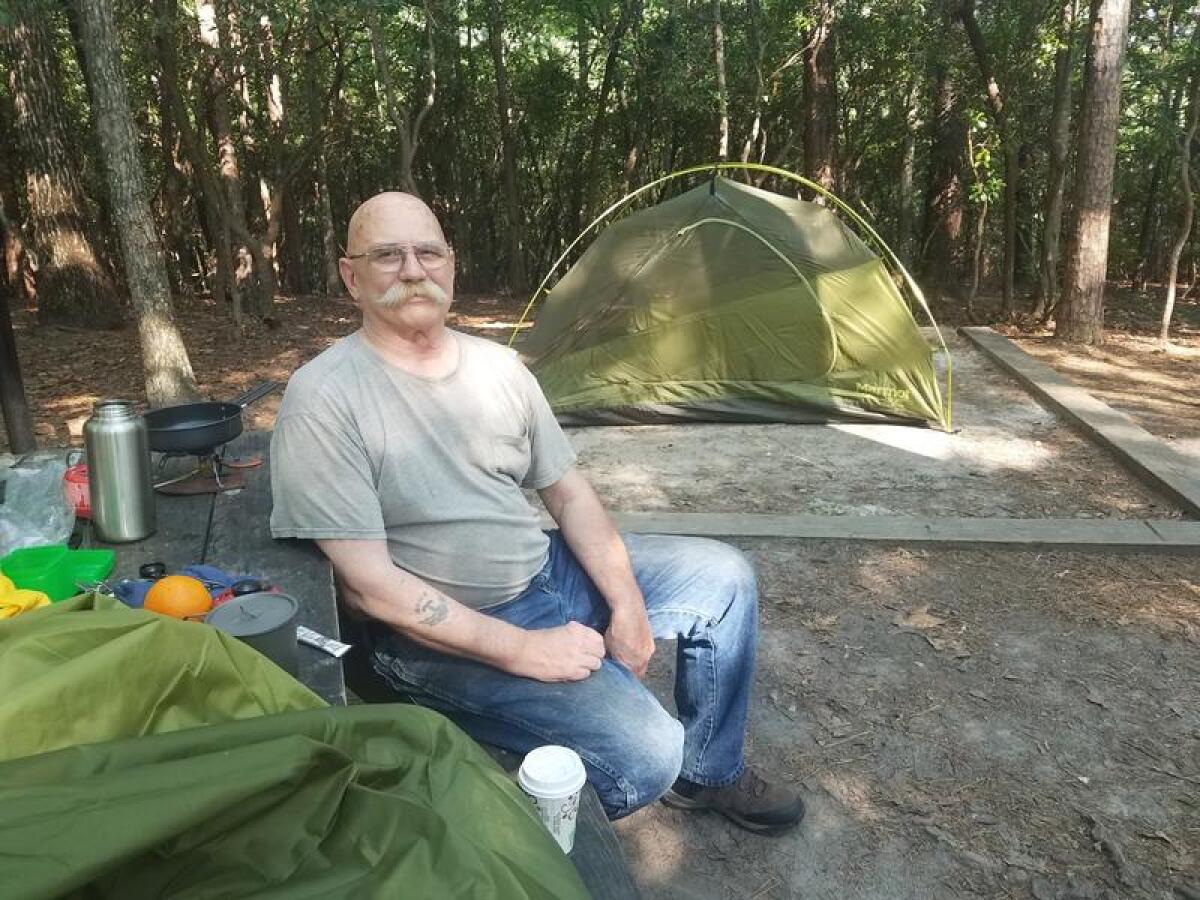
Long before the moon passes between the earth and the sun on the East Coast, Larry Snider plans to walk down to the shore of Lake Jocassee in his heavy-duty welding helmet.
“I’m a science geek,” said Snider, 66, a retired nuclear power machinist. “I’ve been into astronomy since I was a young boy, and I couldn’t miss this.”
Snider, who has seen one total eclipse in his lifetime, drove nearly 1,000 miles from Newfane, Vermont, to enter the path of totality - specifically, a rustic, lakeside camp spot at Devils Fork State Park in northwestern South Carolina.
By mid-morning Monday, signs outside the state park said “parking lot full,” and a park ranger stood in the middle of the park entrance, turning vehicles away.
Inside, hundreds of campers and day trippers from as far as Florida and New Jersey had already set up hammocks, blown up inner tubes and floaties and slathered their bodies with sun screen.
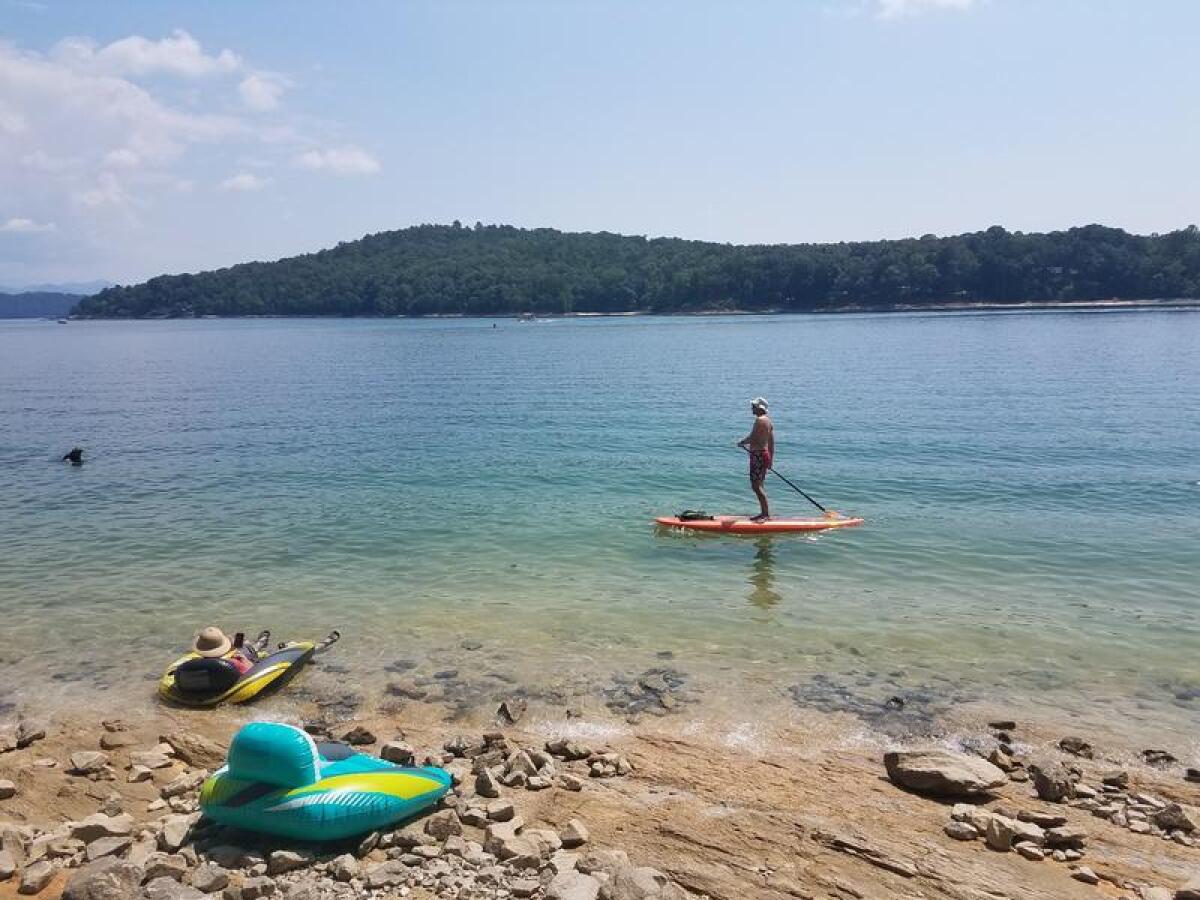
Throngs of families reclined in shade tents as children splashed at the water’s edge and sail boats and jet skis floated on the horizon. A cluster of men set up telescopes and binoculars on tripods on a grassy knoll above a beach.
Some paddled on kayaks, scouting out the best viewing spots on the 7,500-acre lake on the edge of the Sumter National Forest.
“It’s a very beautiful, long, slow passage across the sun,” Snider said of the eclipse as he puffed a cigarette at a picnic table under shade trees.
“To see it in real time, there’s nothing like it... Images and videos don’t do it justice. It’s kind of like looking at Van Gogh in real life versus looking at it in a book.”
- Share via
Looking for a better vantage point to view eclipse in Wyoming
- Share via
Spotted: A pair of Angelenos on eclipse watch in Tennessee
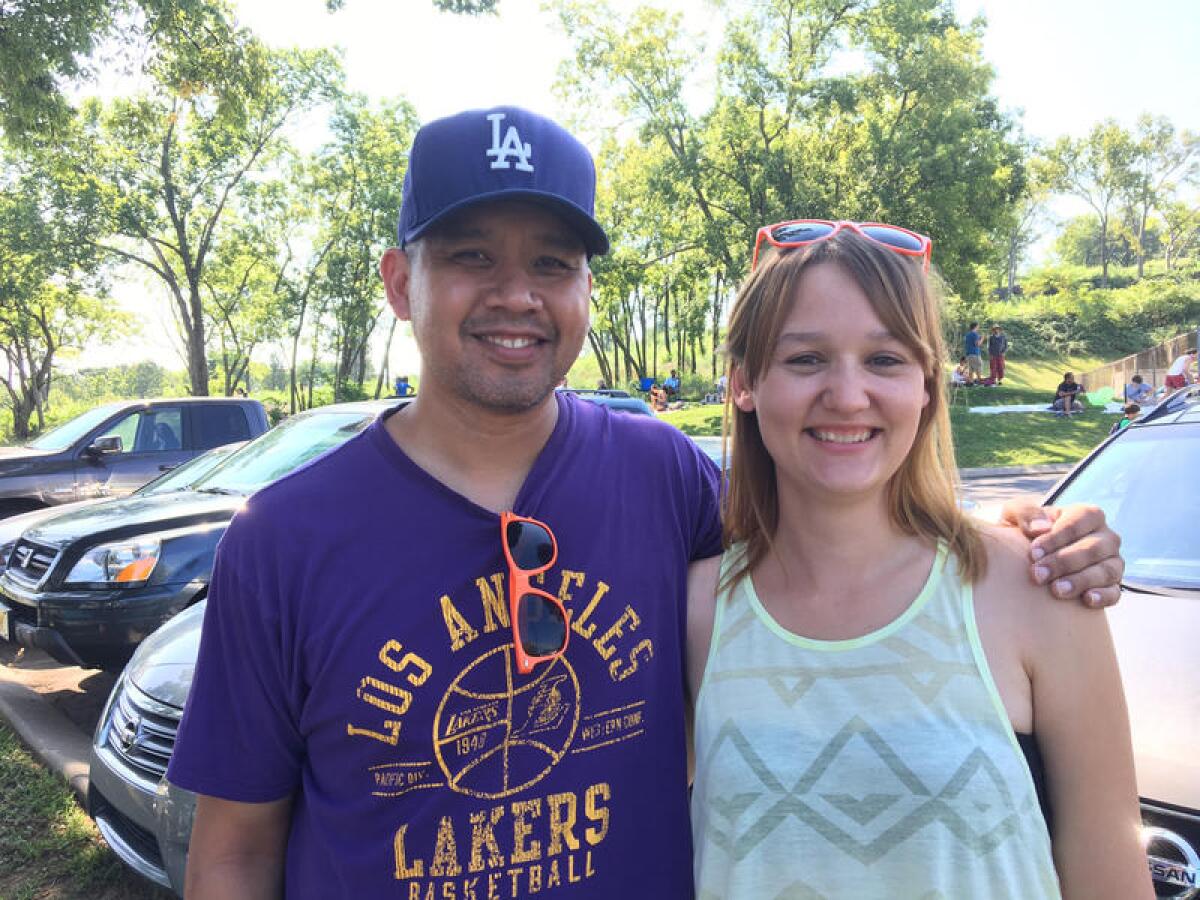
Janna Smith, 32, a transportation planner for the city of Los Angeles, has had this day marked on her calendar for years, and she bought her viewing glasses a month ago.
Claiming some shaded space beneath a tree outside Nashville’s Adventure Science Center, she and her boyfriend, Tony Petborisooth, 42, recounted all the highlights of Tennessee they’ve gotten to see so far: Elvis Presley’s Graceland mansion in Memphis, the Jack Daniels distillery in Lynchburg — and, by chance, they saw a protest at one of memorials to Confederate icon Nathan Bedford Forrest.
Now, they get to see Nashville disappear beneath a full eclipse. You know: The full Tennessee experience.
The two most important things today, according to Petborisooth? “Shade and hydration,” he said. It’s muggy and in the low 90s.
Smith hopes to cling to the shade as long as she can before leaving the tree to see the eclipse. “Hopefully it won’t be super elbow to elbow,” she said.
- Share via
Photos: U.S. readies for solar eclipse
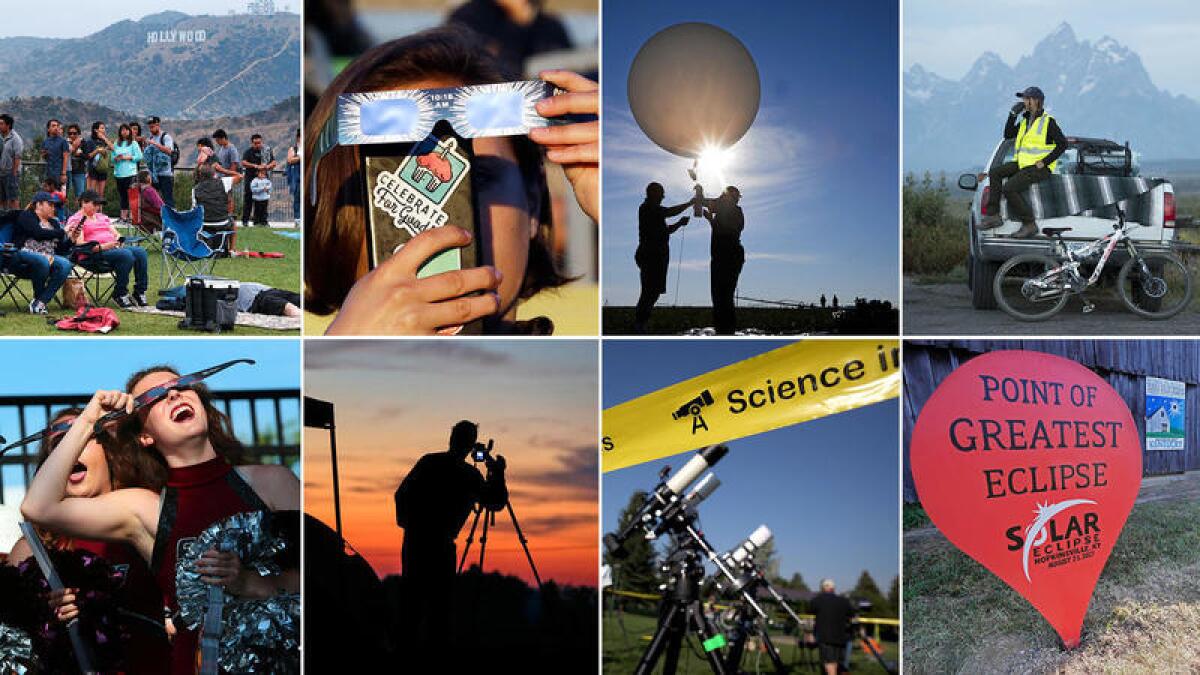
- Share via
Google Doodle celebrates the Great American Eclipse
We earthlings are pretty excited about today’s eclipse. So are a couple of colorful aliens.
These characters — one green, the other pink — are seen passing the moon back and forth across the sun in a new Google Doodle. Each time the moon crosses in front of the sun, it blocks it, creating a total eclipse.
That’s not how it works in real life, of course. The Earth orbits the sun, and the moon orbits the Earth. Every so often, the moon happens to come right between the Earth and the sun, putting us in the moon’s shadow. If the moon blocks the sun completely, it’s a total solar eclipse.
The Google Doodle explains this — along with the reason for a lunar eclipse — with an assist from the animated green alien.
The creature also shares a bit of other eclipse information, including the admonition to wear appropriate eye protection. (Although the alien has only one eye on the top of its head, it sports a two-eyed pair of eclipse glasses. If you’re planning to look at the eclipse, you should be wearing glasses like this too.)
- Share via
How the eclipse will look from Los Angeles
Americans in the continental U.S. will experience at least a partial solar eclipse, or penumbra, when the edges of the moon’s shadow fall across Earth. The sun will still be bright, but the moon will eat a chunk out of it.
On Monday morning, Los Angeles will see the moon begin to edge into the disk of sun.
“At about 9:05 a.m. there will be the first little sort of a bite — a tiny little nibble — taken out of the top of the sun,” said E.C. Krupp, the director of Griffith Observatory, who has seen 14 total solar eclipses (before today).
“Over time it will get larger because the moon is moving more and more into the sun,” Krupp said.
At 10:21 we will be at maximum eclipse.
“At that point the sun will kind of look like a tilted smile in the sky,” he said. “Kind of like a crescent moon.”
But, he emphasized, “you can’t and shouldn’t look at it” without the proper eye protection.
Krupp said the day will get a little darker, but for many people it could go unnoticed. The partial eclipse in Los Angeles will end by 11:45 a.m.
- Share via
Here’s what the eclipse will look like where you are
They aren’t calling it the Great American Eclipse for nothing.
A partial solar eclipse will be visible in every single state among the Lower 48. In most of the country, at least 75% of the sun will be blocked when the moon passes in front of it.
This map shows how much the skies will darken where you are.
It also shows the “path of totality,” the approximately 70-mile-wide band that will experience a total eclipse.
Although you can see the eclipse from anywhere in the continental U.S., you shouldn’t look directly at it without eye protection specifically designed for the job.
Happy viewing!
- Share via
The Great American Eclipse: How to watch it safely
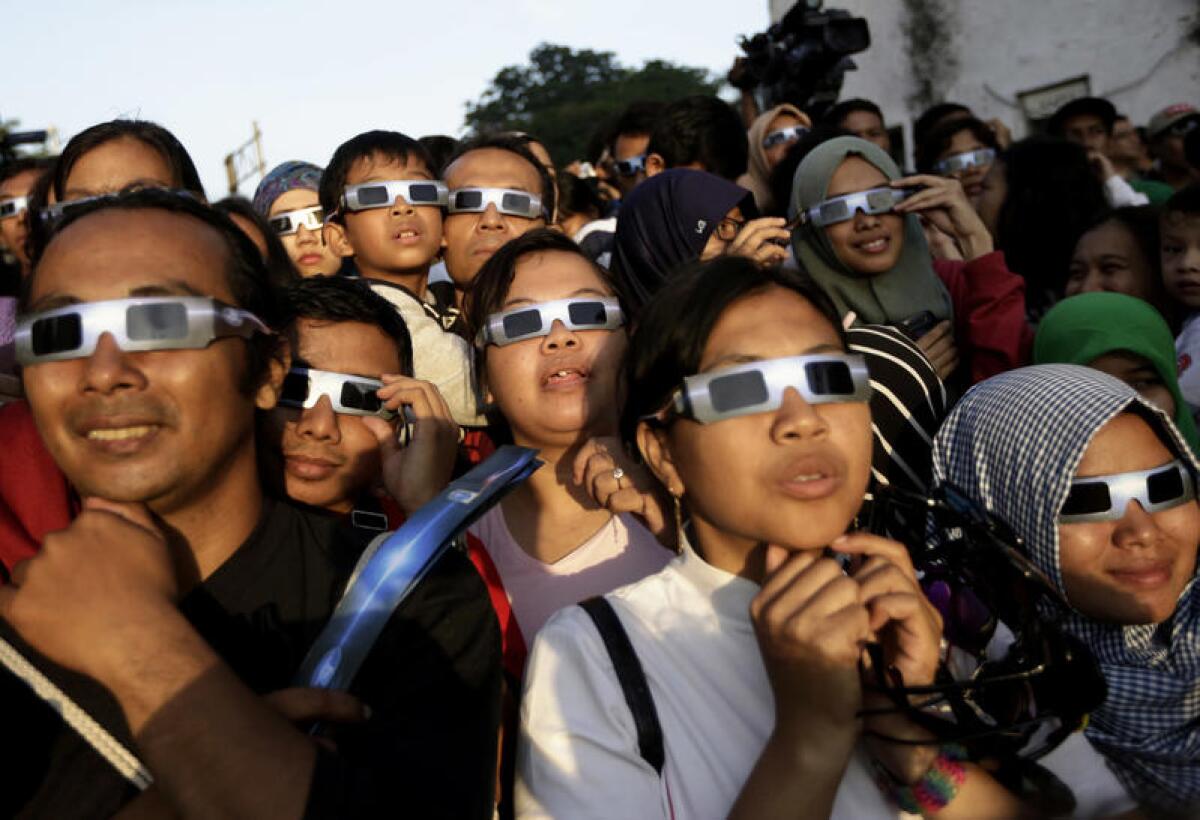
Eclipses pose a bit of a dilemma for sky watchers. Aside from the few minutes of totality, when the moon completely covers the sun, you can’t actually look at the sun directly without hurting your eyes.
Dr. Christopher Quinn, president of the American Optometric Assn., explained that your eyes don’t just absorb the light of the sun. Instead, they concentrate it — focusing it on the light-sensitive tissue at the back of the eye known as the retina.
The cells of the retina are not designed to handle the light intensity that comes from staring directly at the sun.
“It basically coagulates the retina in the center part of the eye — almost cooking it,” he said.
And once the damage is done, it cannot be repaired.
A pair of sunglasses, or even five, won’t offer your eyes the protection they need during most stages of an eclipse.
But don’t despair. If you want to see the eclipse, you’ve got plenty of options.
- Share via
Idaho Falls braces for the world as eclipse mania sweeps the small town
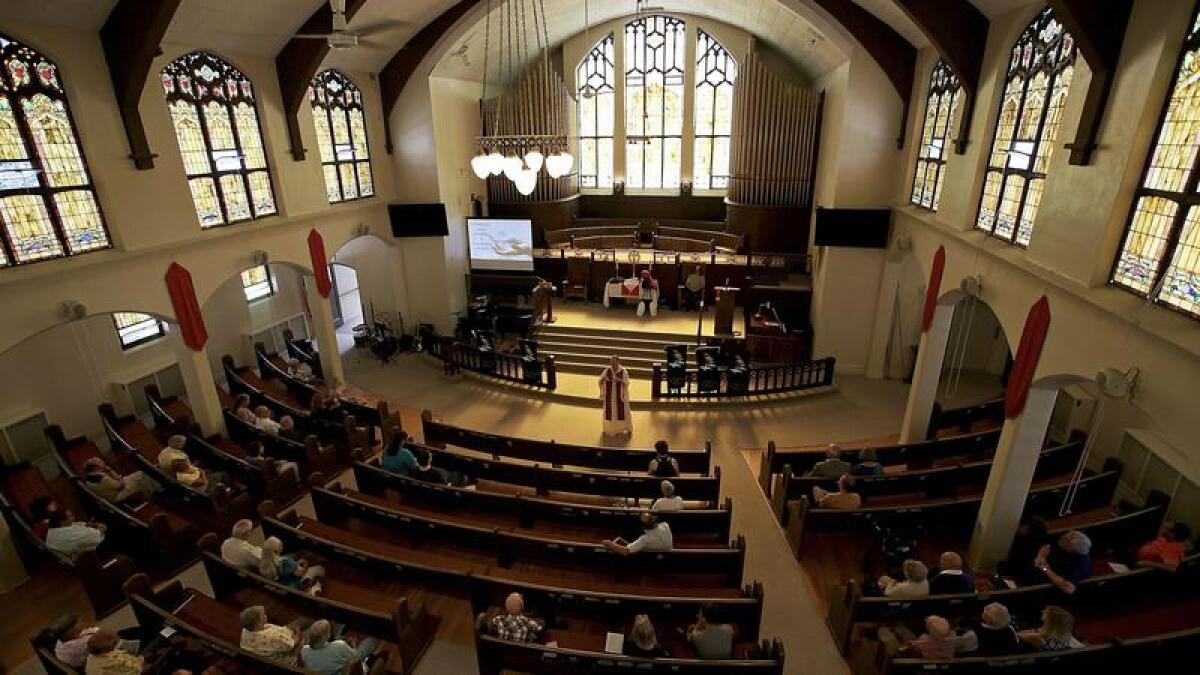
The soft orange light of the Sunday early morning sun filtered through the old church’s stained glass windows while the Rev. Ruth Marsh stepped down from the altar and asked her congregants if they had any special prayer requests.
“For sanity. For safety,” a voice called out. “It’s kind of scary to think that many people are coming.”
Somebody near the front of Trinity United Methodist Church asked for prayers that the infrastructure of Idaho Falls would survive. And, dear God, no fires please.
With the nation riveted by the pending arrival of an extremely rare coast-to-coast solar eclipse, prime viewing spots such as Idaho Falls are bracing for traffic congestion, strains on infrastructure, an economic boost and some inflation — and hoping for clear skies.
The sun, moon and Earth won’t come into alignment until Monday, but the eclipse has already shaded nearly every aspect of life in this town of about 50,000 that straddles a tree-lined section of the Snake River and counts fishing and kayaking as its biggest tourist attractions.
The largest event each year is the Fourth of July celebration that draws about 100,000. If estimates are to be believed, the population in the area could grow up to 10 times that amount for the eclipse.
“They’re telling us to have four days of water stored, prepare for power outages and even gas has already gone up 20 cents a gallon in the last week,” Cindy Isaacson said.
- Share via
Nine places to watch the Great American Eclipse around Los Angeles
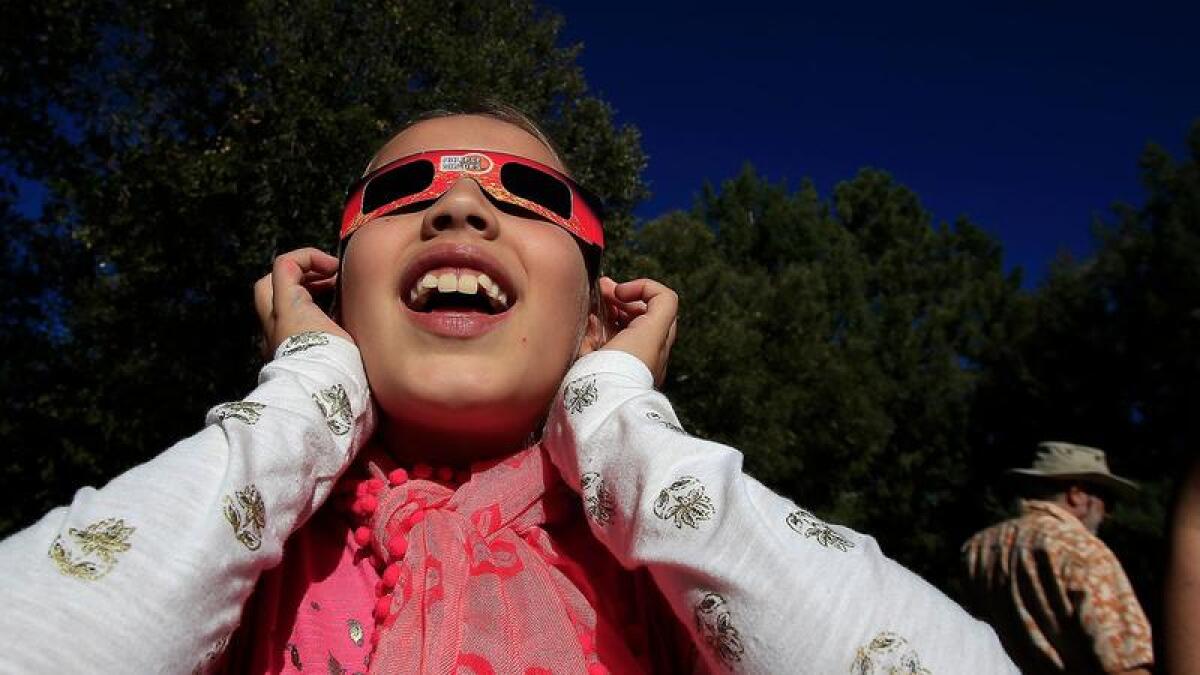
Los Angeles has a lot going for it: the sunshine, the mountains, the ocean, the food.
But on the day of the Great American Eclipse, it won’t exactly be the place to be.
Here in L.A., we’ll experience a partial eclipse. Even at the point of greatest eclipse, just 62% of the sun will be obscured by the moon. No darkness. No stars. No animals acting funny.
Still, there’s no reason to sulk. With a pair of eclipse glasses at the ready, you can still get a glimpse of the cosmic alignment of our sun, moon and Earth. (Remember, never, ever look at the sun without protection).
In Los Angeles, the show begins at 9:05 a.m. local time, when the moon first starts to pass across the face of the sun. The point of greatest eclipse, when the largest percentage of the sun is covered by the moon, will occur at 10:20 a.m. The event ends at 11:43 a.m
Technically, all you have to do to see the eclipse is step outside, put on your eclipse glasses and look at the sun. But if you want some company — or some experts to talk to — there are plenty of eclipse-viewing events scheduled across the area.
- Share via
Buying eclipse glasses from a scalper? They might not be real
Would you trust a stranger with the health of your eyesight?
In Nashville, the largest city in the path of the solar eclipse, you can still buy protective glasses to watch the eclipse. The problem is knowing whether the glasses are actually safe.
As watchers filed into the watch festival outside Adventure Science Center, a pair of young men hollered offers to sell solar glasses for $10 — cash — to anyone who’d forgotten to buy a pair in advance.
At first glance, they certainly look official. They came in stacks in sealed plastic bags and had safety instructions printed on the back, along with the word “CERTIFIED.”
But who made them? There’s no manufacturer listed on them, nor any tracking or contact information that might help you locate the seller if they turned out to be defective.
At one of the official Adventure Science Center vendor tents, the glasses for sale for $2 come with all sorts of information printed on the back — the name of the manufacturer, contact information, a bar code.
The glasses also include the all-important safety designation, the international safety standard number “ISO 12312-2” — though even then, you should be careful, as the American Astronomical Society warns that unscrupulous vendors might print the number on fake glasses without getting the proper testing.
That’s important for the health of last-minute eclipse watchers such as Oscar Ayarza, 52, a bicyclist who didn’t plan on watching the eclipse until he realized that he would have time while biking from a work shift to a chiropractor’s appointment to catch the eclipse.
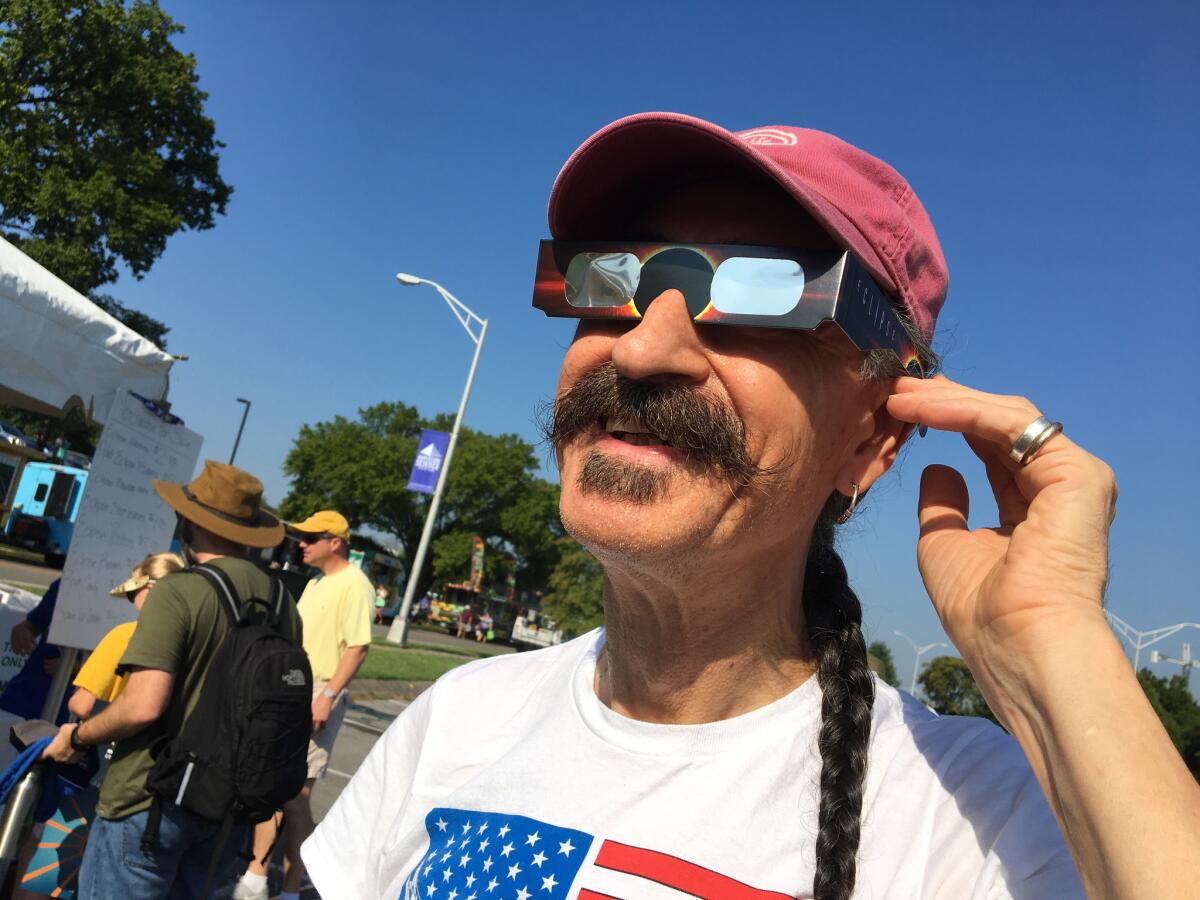
“I chanced it,” Ayarza said of coming to the science center, hoping official glasses would still be available for sale. He got two pairs — one for his roommate — and thought about getting more, just in case, but he decided he should let other festival attendees have a chance to pick up a pair.
Standing outside the tent, he put on the official glasses, which had silvery lenses that flashed brightly in the full morning sunlight.
“I can’t see anything with these,” Ayarza said — anything except the sun.
- Share via
Boarding the Nerd Train in Portland, destination total eclipse
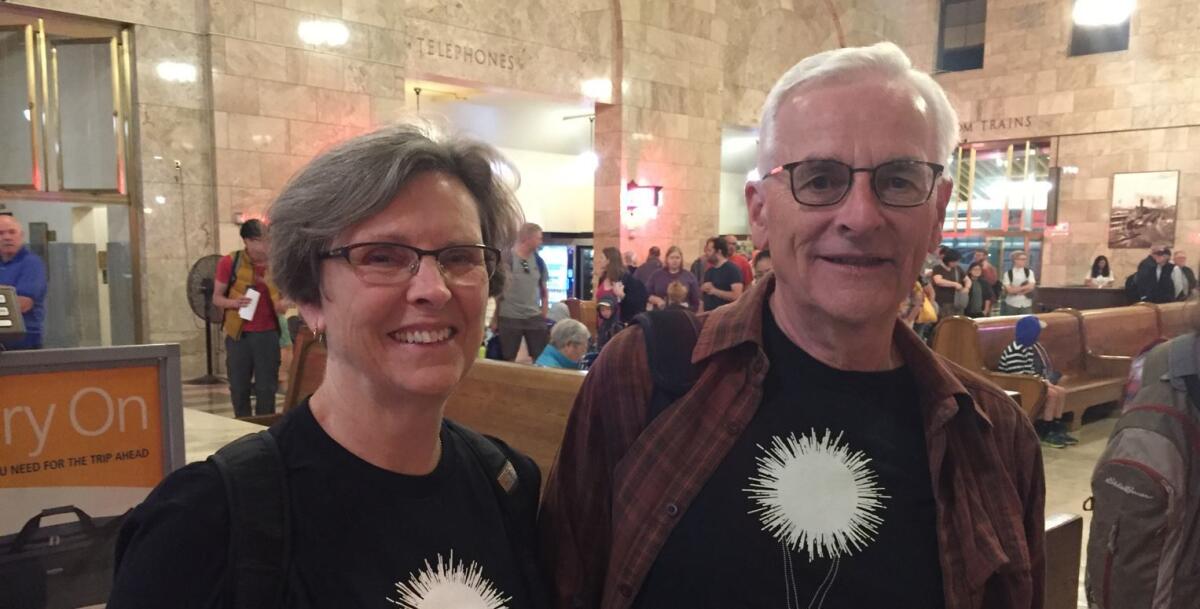
You could call it the “Nerd Train,” but its real name is the Solar Eclipse Special.
It’s evidence, as much as anything in Portland, Ore., that the eclipse is a Thing You Can’t Leave to Chance.
Hopping a fast-moving train from Portland’s Union Station to the Oregon State Fairgrounds for an Oregon Museum of Science and Industry viewing party appears to be a favored way of seeing the first total solar eclipse to hit the contiguous United States since 1979.
Waiting in a fast-moving line at 5 a.m. this morning to board, the thought of staying in Portland made Tom Honohan shake his head. The fairgrounds in Salem, Ore., are in the path of totality, an hour south; Portland’s view is a comparatively underwhelming 99.2%.
“The difference between 90% and 100% is like 1,000 times,” said Honohan, clad in a special black-and-white T-shirt featuring a geometric representation of the eclipse.
Like many of those in line, Honohan and his wife, Judy, have a scientific background —she as a science teacher, he as a chemist. The Oregon Museum of Science and Industry’s Salem viewing party is expected to attract up to 8,500 people.
“There’s over 67 groups that inquired about it,” District and Station Manager Dan Valley said in between handing out information sheets and fielding a stream of questions near the center of Union Station. “It sold out in less than 48 hours.”
Several people in line said they’d experienced a total eclipse before. Self-described “computer geek” Ed Borasky, 75 — who wore a fisherman’s cap, a pocket protector and a bushy white beard — said he was in Maine for a total eclipse in 1963.
“The birds all shut down, because they think it’s night,” he said. Like Honohan, Borasky clucked at a reporter’s folly, not traveling to the path of totality.
“You won’t see the corona and Bailey’s Beads,” Borasky said, referring to the beads of sunlight that are just visible during a full eclipse. “And there’s waves — atmospheric waves.”
Jim Laden stood in line in front of Borasky with his husband of 25 years, State Rep. Rob Nosse, whose district includes the science museum in southeast Portland.
“I saw [a total eclipse] in India in 1995,” Laden said.
“At the Taj Mahal — he’s leaving that part out,” Nosse added.
“I love nerds,” Nosse said, when asked if the train he was about to board could fairly be called the Nerd Train.
“I think that it’s the Curious Portlander Train,” Laden said.
- Share via
Tips for taking the best pictures of the Great American Eclipse
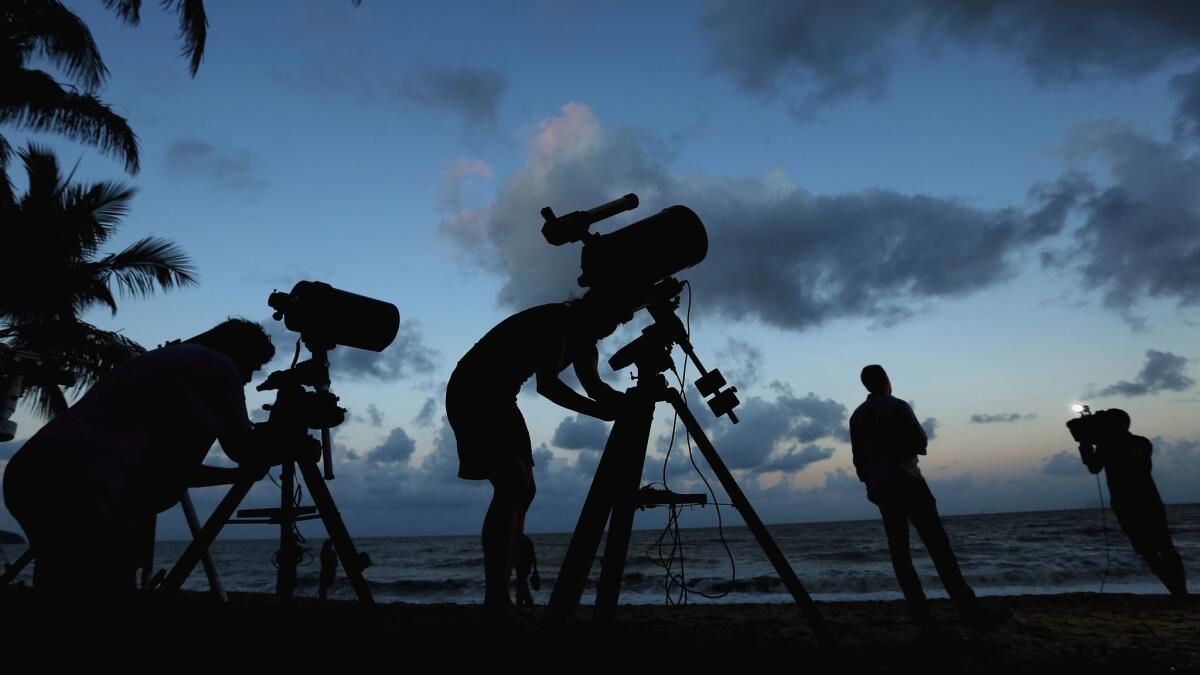
The Great American Eclipse is almost here.
The total solar eclipse will span the country from coast to coast for the first time since 1918. Millions of people are expected to don eclipse glasses and watch as the moon appears to blot out the sun.
People naturally want to commemorate this historic event. If you’re planning to photograph the eclipse, here are some tips and guidelines from the experts.
- Share via
It’s about to get dark. Keep looking for a clear view of the eclipse? Or order another chardonnay?
Several small wineries in and around this German-inspired town were expecting hundreds of eclipse chasers Monday despite a 50-50 chance of cloudy weather.
Wineries, including Lost Creek and Stone Hill, in this region of Norton and Chardonel grapes have been preparing for weeks based on a long list of planned visitors.
As one of the few major Midwestern cities near the path of totality, St. Louis has attracted eclipse tourists from across the upper Midwest — some coming from as far away as Ontario, Wisconsin and Illinois.
And Hermann — an hour’s drive outside St. Louis on the edge of the Missouri River — is among the idyllic spots closest to the path of totality. Nearly everyone in town Sunday dropped into conversation about the eclipse on winery tours and inside restaurants.
But weather forecasts for Monday showed clouds were likely to come in by the afternoon, threatening to block any view of the eclipse. Some visitors said they might just end up staying on the road until they found clear skies.
More traffic jams ahead.
- Share via
There was a blackout in central Oregon, but it was a fire, not an eclipse

Fire threatens resort full of eclipse tourists in Oregon
The first blackout photographed by seven busloads of Japanese tourists arriving at the Kah-Nee-Ta resort in north-central Oregon wasn’t caused by the moon eclipsing the sun.
It was damage from the Nena Springs fire, which blew containment lines and charred hills surrounding the resort, resulting in a Level 3 (Go Now) evacuation order. That came as more than a little surprise when the tour group rolled in earlier this week, says group sales manager Cruz Bocanegra.
“We had a lot of the guests standing out front taking pictures,” Bocanegra said. “We had a state fire marshal in, there were [fire] engines from all over.”
If Bocanegra sounds nonchalant while describing the situation, it’s because wildfires near the resort, on Warm Springs Indian Reservation, have become a near-annual occurrence, he said. But the fire has burned more than 68,000 acres so far — more than a tenth of Oregon’s largest Indian reservation, said Robyn Broyles, spokeswoman for the National Interagency Fire Center.
Another fire a dozen miles to the south has zero containment after burning 8,000 acres.
Broyles said the Nena Springs fire’s progress toward the resort, a center for eclipse tourists, was halted by four task forces, including 79 firefighters and 23 fire trucks.
The evacuation order was issued Thursday afternoon, Bocanegra said. Its timing, just hours before the first of the 272 Japanese eclipse watchers showed up, was “weirdly coincidental,” he added, and caused staff members to quickly shift from translating menus into Japanese to more urgent duties.
However, the resort has a standing “shelter in place” order, Bocanegra noted. “We did actually technically get evacuated, so any day guests that were not staying overnight were told, ‘If you aren’t staying overnight, please leave,’” Bocanegra said.
He’s optimistic that the skies will be clear for the eclipse.
“The one that was here, the smoke’s blowing away, so we’re feeling pretty good that it’s going to be a good morning” for eclipse watching, he said.
Broyles says Kah-Nee-Ta is now at a lower Level 1 evacuation order, but the fire is not yet out. A Red Cross evacuation center at the Warm Springs Community Center is still open.
- Share via
Solar eclipse gridlock: It was so busy in Madras, Ore., they called in the National Guard
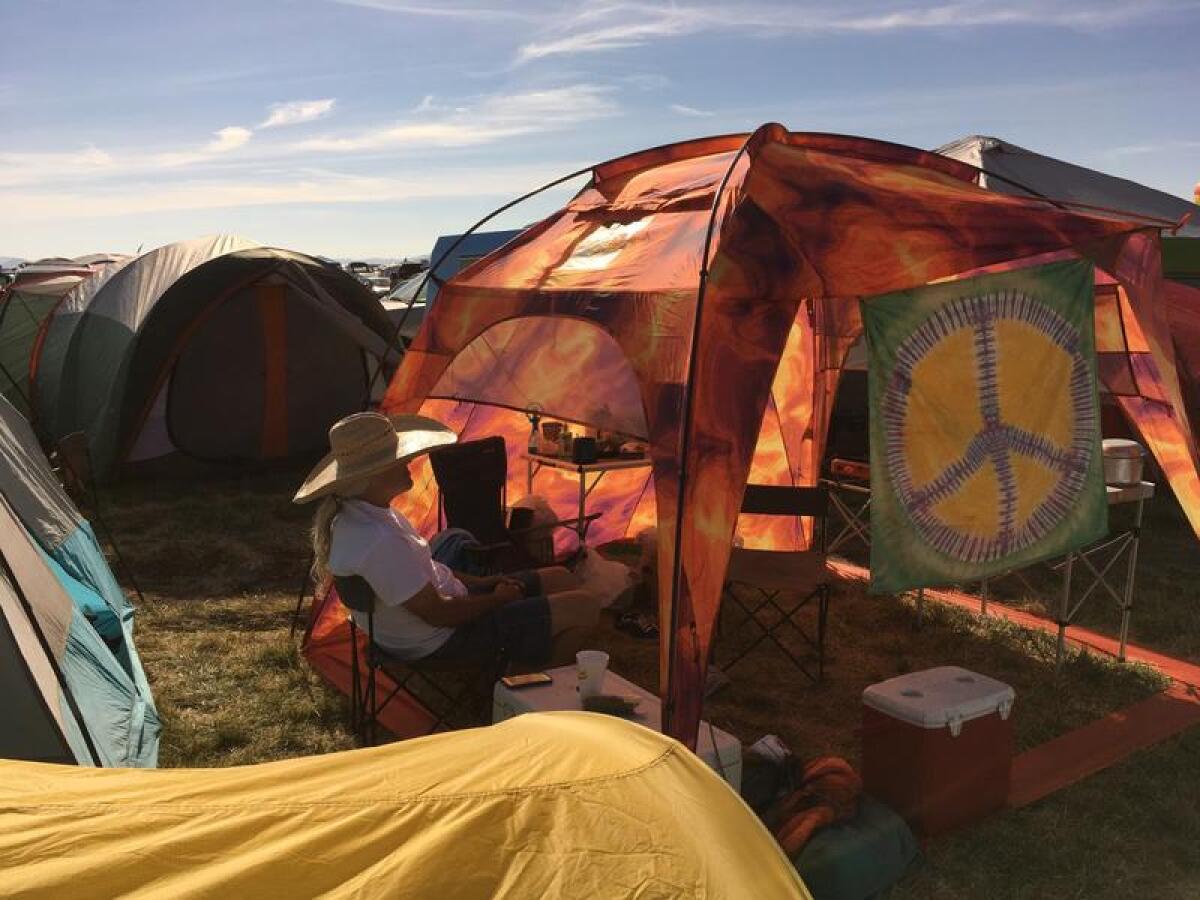
Oregon has long been predicted to be a scene of major eclipse traffic jams, and even by Sunday, that was proving to be true: The Oregon National Guard was called in to Madras, a small agricultural city in the sunny part of the state, east of the Cascades.
Traffic was at a standstill for hours Sunday afternoon, gridlocked as well more than 100,000 people flocked to this small, pleasant town of 7,000.
Madras, pronounced like glad or sad — not like the plaid fabric or the megalopolis in India — sits on the centerline of the eclipse’s path of totality.
At Solarfest, a gathering at the Jefferson County fairgrounds that bills itself as a festival of music, science, camping and art, a pushpin map of the world marking where visitors had come from had so many pins there was no more room to document visitors from the western United States. Europe and South America were well-represented. A couple of pins were pushed into Guam. There were marked travelers from Tehran.
Many acres of farmland were turned over to a city of tents and motor homes.
Mt. Hood and Mt. Bachelor thrust into blue skies as hot air balloons fluttered through one part of the sky and a constant stream of skydivers rained down in another.
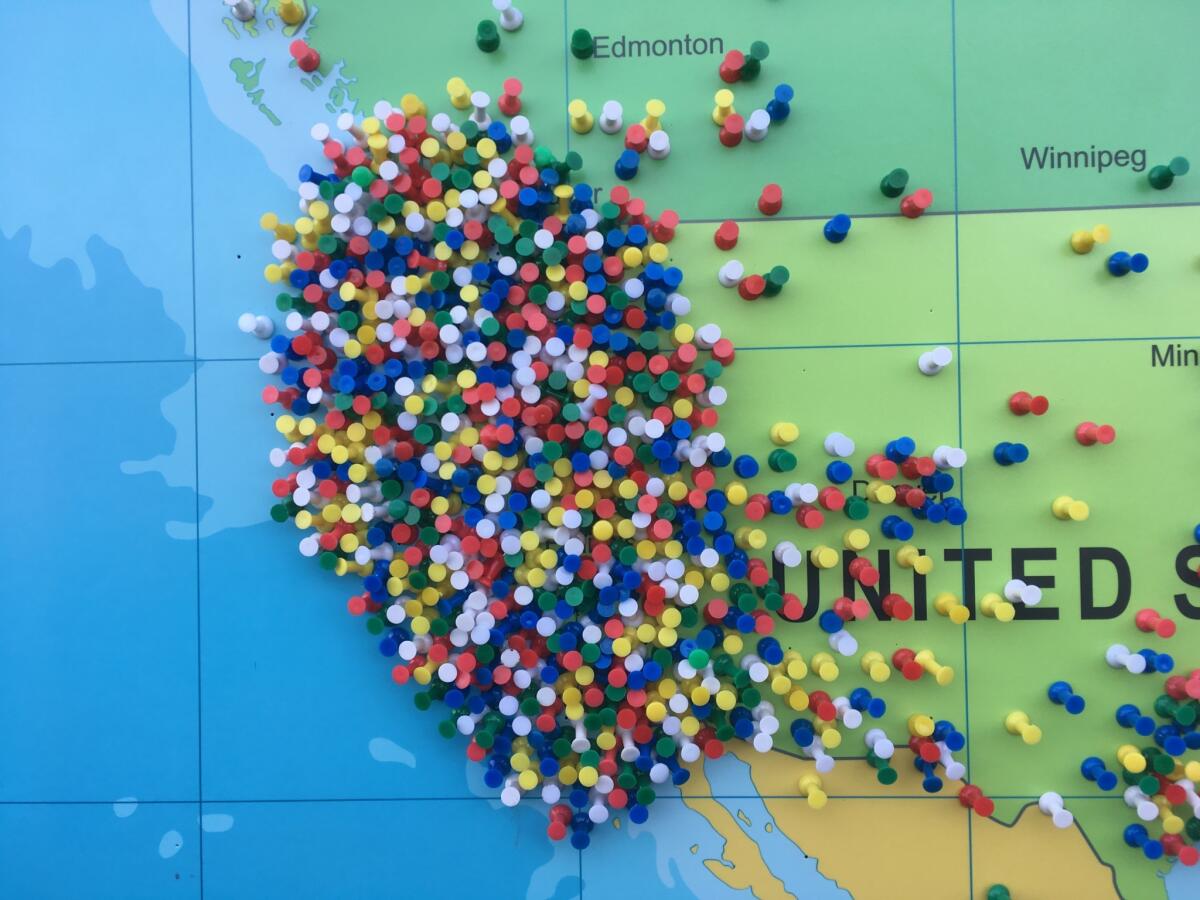
Rob Buckley flew with his family from Bristol, England, and set up camp. Buckley witnessed a total eclipse in Britain years ago. Though the sky had been thick with fog, the experience was wondrous enough to warrant a full family flight to a sunnier spot this time around.
His wife, curiously enough named Sun, was a total eclipse virgin. Their two kids, 7 and 9, had never witnessed an eclipse of any kind.
After the sky goes bright again Monday morning, traffic heading back to the airport will be horrendous. But with the sense of anticipation building Sunday, that didn’t seem to matter.
- Share via
‘The shadow of shadows’: A scientist waits to take the measure of a full solar eclipse
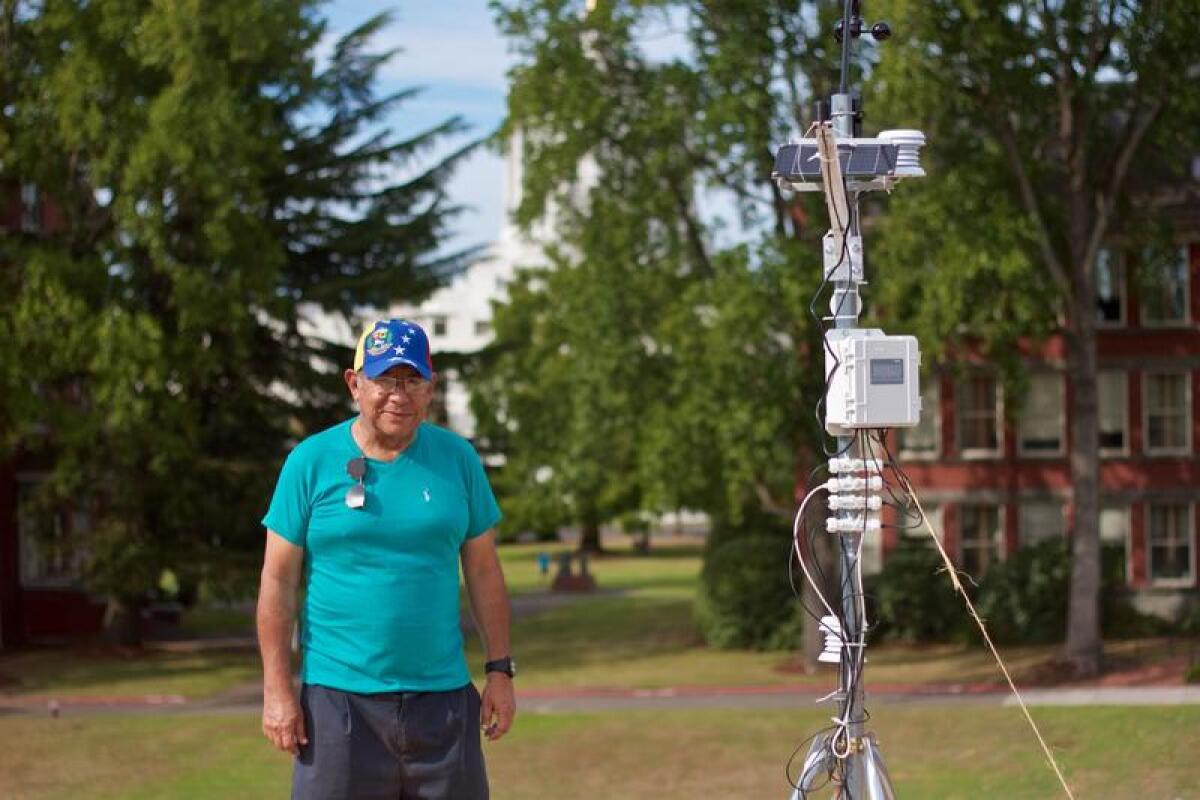
Marcos Peñaloza-Murillo is a scientist with the soul of a poet.
He’s an atmospheric physicist from Venezuela, and he’s here in Salem, the state capital of Oregon, to study how a total solar eclipse affects the planet.
On Sunday afternoon, fewer than 24 hours before the Great American Eclipse will sweep across the United States, Peñaloza-Murillo took a small group of students to the top of a brick building at Willamette University in Salem to check on a spindly weather station.
It was already hard at work measuring the air temperature, wind speed, wind direction, barometric pressure, humidity and the brightness of the sun. The data it collected Sunday will be used as a control to the data it will take during the eclipse on Monday.
“I have fallen in love with this machine,” Peñaloza-Murillo said. “I will miss it when it when this is over.”
He is not entirely sure what the data will show when the eclipse is over. He knows that the temperature will go down and the amount of sunlight will decrease. But will the winds change when the lights go out? Will the humidity be altered?
“We have no idea,” he said.
What he does know, from prior experience, is that the eclipse will have an effect on him.
“In my mind, in my soul, there is a change,” he said. “This is the shadow of shadows. This is the big one.”
- Share via
The Great American Eclipse could create the largest traffic jam in U.S. history
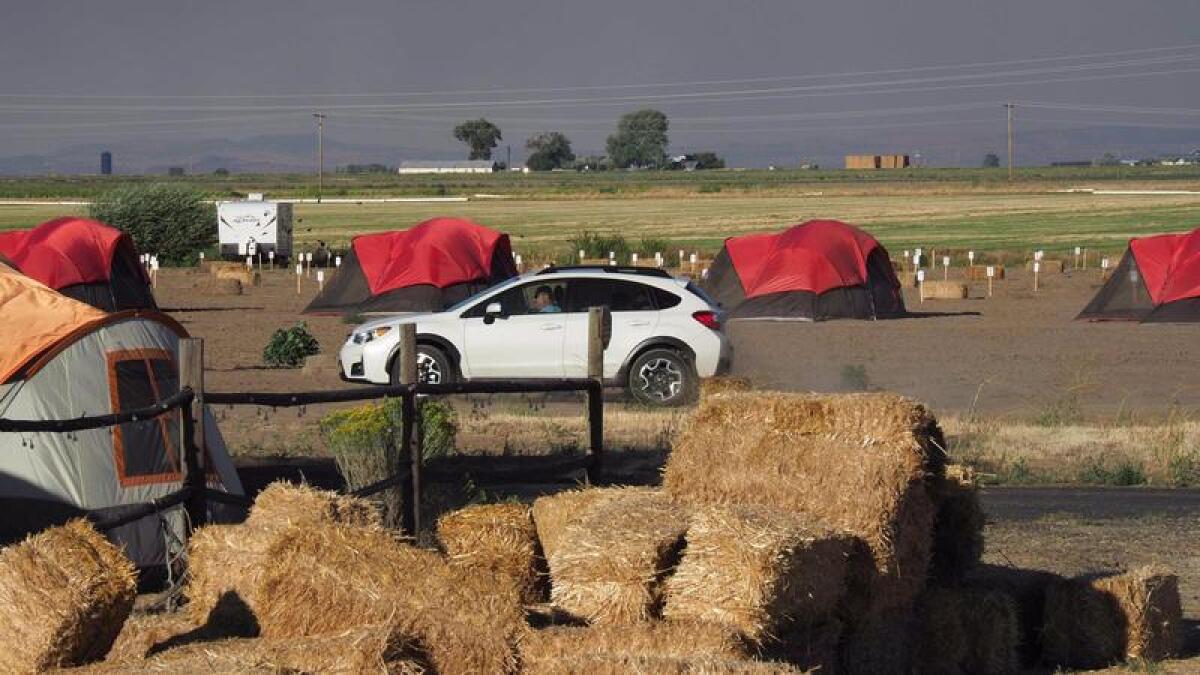
Most weekdays, a steady stream of cars and pickups winds down U.S. Route 441 through this tiny mountain town.
Locals stop to stock up on bread and eggs at the Piggly Wiggly. Tourists browse a string of antique stores. Nearly everyone pulls over at the Osage Farm stand to pick up ripe peaches, silver queen corn and heirloom tomatoes.
This Monday will be different.
Dillard, population 330, is the prime spot in Georgia for viewing the first total solar eclipse in 99 year to sweep the continental U.S. The town sits in the Appalachian foothills north of Rabun County, where authorities expect an extra 50,000 cars on its two narrow highways and small state and county roads.
“There’s no way tens of thousands of extra cars can pass this skinny road going up the mountain,” said Louis Meinhardt, 74, a resident of nearby Scaly Mountain, N.C. “Just one accident and everyone will be backed up for miles.”
Local sheriffs and highway patrol officers from across the country are bracing for what they say could be the largest traffic snarl in U.S. history as the so-called Great American Eclipse cuts a diagonal, 70-mile-wide path through 14 states from Oregon to South Carolina.
- Share via
Your solar eclipse checklist: What to look for on the big day
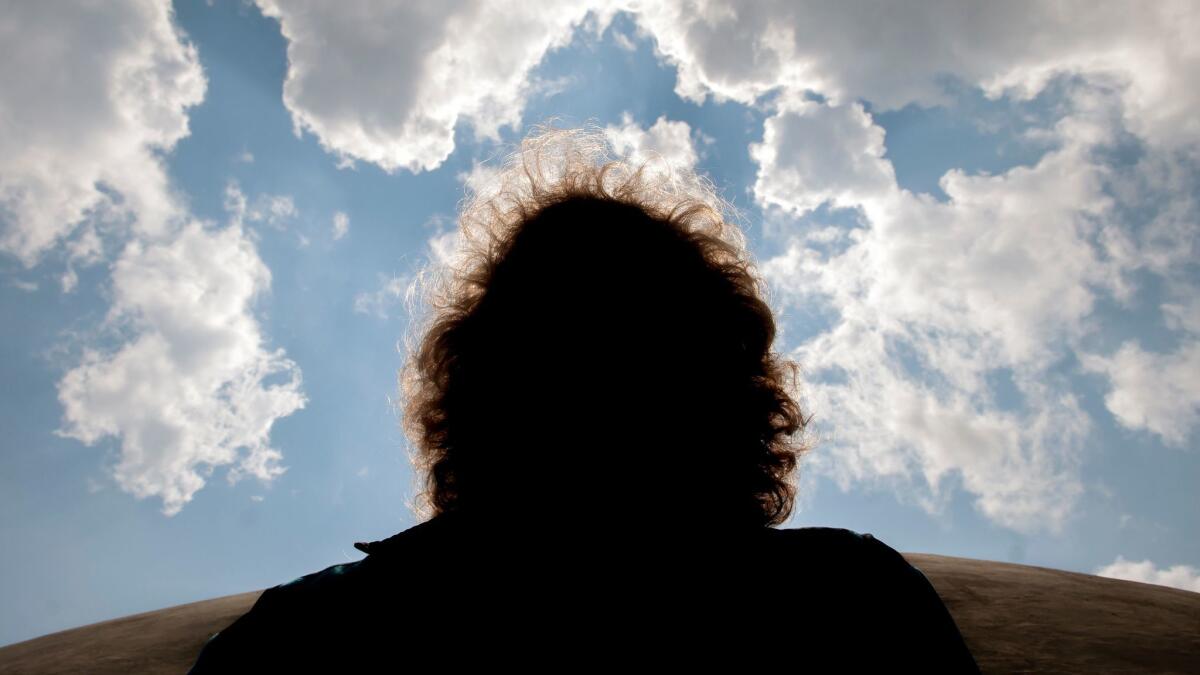
Eclipse chasers will tell you that seeing a total solar eclipse will change your life.
But keep in mind, a total eclipse is a fleeting phenomenon.
That moment of totality, when the moon completely obscures the face of the sun and the daytime sky plunges into darkness, lasts just a few minutes.
So obviously you are going to want to make the most of your brief moment out of the sun.
If you’ve never seen a total eclipse, you may not know what to expect or what to look for as the world grows dark.
To help you out, we asked a few of our favorite eclipse enthusiasts to tell us what you should do during the total eclipse.